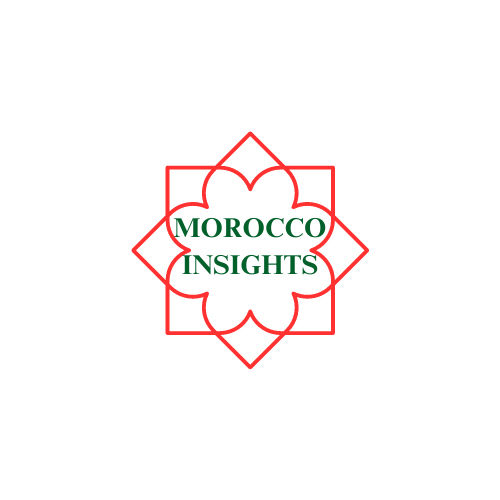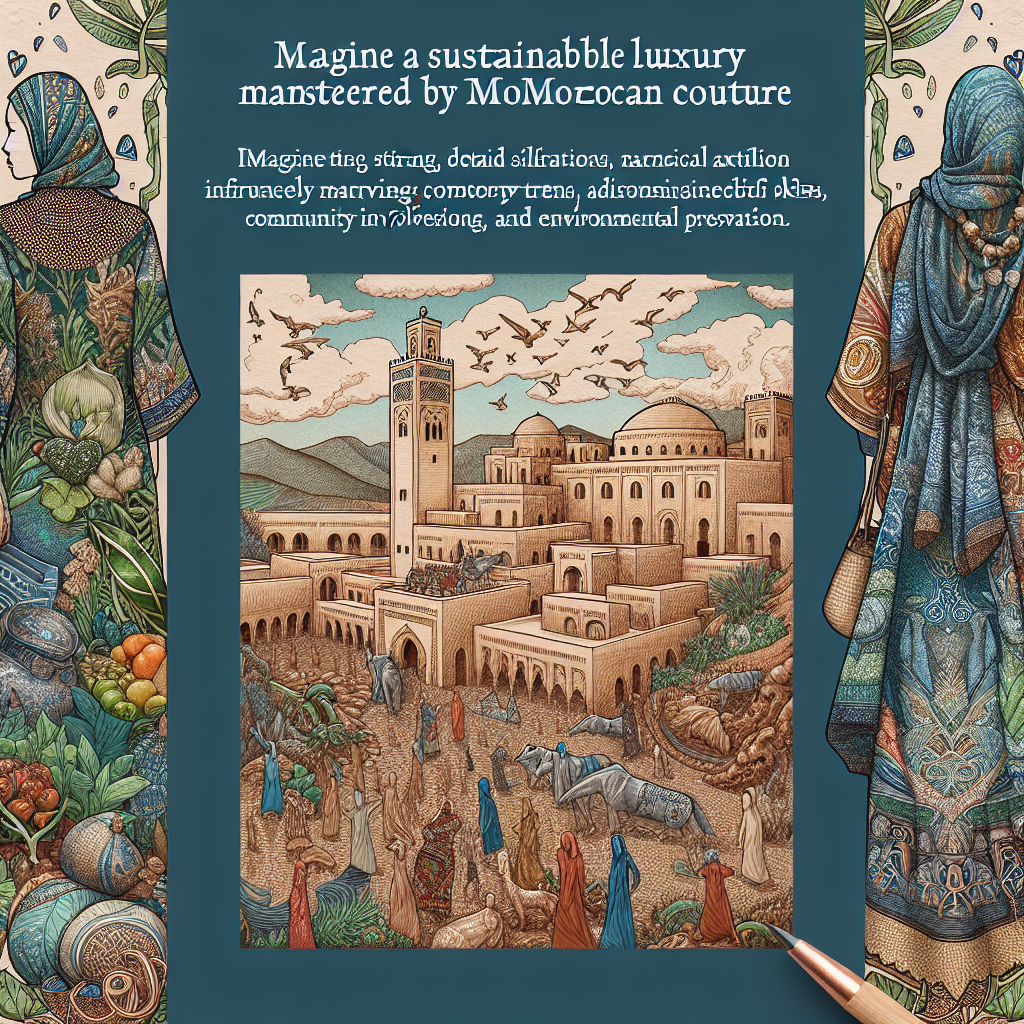Step into the colorful world of Moroccan fashion, where tradition meets modernity in a vibrant tapestry of style and craftsmanship. Moroccan fashion designers are the visionaries behind this fusion, skillfully blending centuries-old techniques with contemporary trends. Not only are they creating unique and statement-making pieces, but they are also championing sustainable and ethical fashion practices. Through their work, they showcase the incredible artistry and diversity of Moroccan design, reflecting the country’s commitment to craftsmanship and community. Step behind the scenes of Moroccan fashion events and shows to discover the approaches these designers take to sustainable luxury, and how their creations continue to inspire and influence global fashion trends.
1. Introduction to Sustainable Luxury
Sustainable luxury is a concept that combines the beauty of luxury fashion with ethical and environmentally-friendly practices. It goes beyond creating exquisite designs and focuses on promoting sustainability throughout the entire fashion industry. Morocco, with its rich cultural heritage and vibrant fashion scene, has emerged as a hub for sustainable luxury. Moroccan fashion designers are embracing this movement, finding innovative ways to merge traditional techniques with modern sustainability practices. In this article, we will explore the history and significance of sustainable fashion in Morocco, the designers who are leading the way, the innovations in sustainable luxury, the impact of Moroccan designers on the global stage, as well as the challenges and future of sustainable luxury in Moroccan fashion.
2. Sustainable Fashion in Morocco
2.1 History and Cultural Significance
Moroccan fashion draws inspiration from centuries-old traditions and has a deep cultural significance. The traditional Moroccan garment, known as the caftan, is intricately embroidered and reflects the country’s unique aesthetic. Over the years, Morocco has also been influenced by Islamic, African, and Mediterranean styles, creating a diverse and vibrant fashion landscape. With the rise of environmental consciousness and the need for sustainable practices, Moroccan fashion has also evolved to embrace sustainability.
2.2 Current Fashion Landscape
In recent years, the fashion industry in Morocco has experienced a significant shift towards sustainable practices. Designers, both emerging and established, are integrating sustainability into their creative processes, materials, and production techniques. Moroccan fashion weeks and events are now platforms for showcasing the latest sustainable designs, attracting attention from fashion enthusiasts and industry professionals from around the world.
2.3 Importance of Sustainable Fashion
Sustainable fashion is crucial not only for the environment but also for the well-being of the people involved in the fashion industry. By adopting sustainable practices, designers in Morocco are promoting ethical production, fair trade, and community empowerment. They are also raising awareness about the importance of preserving traditional techniques and craftsmanship. Through sustainable fashion, Morocco is not only contributing to the global movement towards environmentally-friendly practices but also preserving its rich cultural heritage.
3. Moroccan Fashion Designers Embracing Sustainable Luxury
Moroccan fashion designers are at the forefront of the sustainable luxury movement, incorporating eco-friendly practices into their design philosophies. Let’s explore some of the notable designers who are leading the way in sustainable fashion in Morocco.
3.1 Designer 1: [Designer Name]
3.1.1 Background and Design Philosophy
Designer 1, with their unique background and design philosophy, has gained recognition for their commitment to sustainable luxury. Their designs often reflect traditional Moroccan techniques while embracing modernity and ethical practices.
3.1.2 Commitment to Sustainable Practices
Designer 1 is deeply committed to sustainable practices in all aspects of their work. They prioritize using organic, recycled, and ethically sourced materials to minimize their environmental impact. They also ensure that their production processes adhere to the highest ethical standards, promoting fair labor practices and supporting local artisans.
3.1.3 Sustainable Materials and Techniques Used
Designer 1 incorporates sustainable materials such as organic cotton, hemp, and ethically sourced leather into their designs. They also utilize techniques such as natural dyeing, which reduces the use of harmful chemicals. By embracing these sustainable materials and techniques, they create beautiful pieces that are both environmentally-friendly and aesthetically appealing.
3.1.4 Collaborations and Partnerships
Designer 1 actively collaborates with local artisans and craftsmen, supporting their communities and promoting traditional techniques. They also partner with sustainable fashion organizations and initiatives to further spread awareness about sustainable luxury in Morocco and beyond.
3.2 Designer 2: [Designer Name]
3.2.1 Background and Design Philosophy
Designer 2 brings a fresh perspective to sustainable luxury in Moroccan fashion. Their design philosophy centers around minimalism, paying homage to traditional Moroccan aesthetics while embracing contemporary fashion trends.
3.2.2 Commitment to Sustainable Practices
Designer 2 prioritizes sustainability from the initial stages of design to the final product. They carefully select materials that are not only eco-friendly but also promote fair trade and support local communities. Their production processes are designed to minimize waste and carbon footprint.
3.2.3 Sustainable Materials and Techniques Used
Designer 2 incorporates organic fabrics, recycled materials, and innovative fibers into their designs. They experiment with traditional techniques such as hand weaving and hand embroidery, breathing new life into these age-old practices and making them relevant in the context of sustainable luxury.
3.2.4 Collaborations and Partnerships
Designer 2 actively collaborates with sustainable textile manufacturers and artisans, creating a network of like-minded individuals passionate about sustainable fashion. Through these partnerships, they aim to inspire change and promote sustainable practices within the Moroccan fashion industry.
3.3 Designer 3: [Designer Name]
3.3.1 Background and Design Philosophy
Designer 3 takes a bold approach to sustainable luxury, pushing boundaries and challenging the norms of traditional Moroccan fashion. Their designs often showcase a fusion of traditional elements with modern influences, reflecting their unique design philosophy.
3.3.2 Commitment to Sustainable Practices
Designer 3 is committed to redefining luxury fashion by incorporating sustainable practices that benefit both the environment and the local communities. They prioritize transparency and traceability, ensuring that every step of their supply chain adheres to ethical and sustainable standards.
3.3.3 Sustainable Materials and Techniques Used
Designer 3 explores innovative materials such as recycled plastics and regenerated fibers, transforming waste into high-end fashion pieces. They also experiment with upcycling techniques, breathing new life into discarded garments and materials.
3.3.4 Collaborations and Partnerships
Designer 3 collaborates with fashion and sustainability initiatives, forging partnerships to raise awareness about sustainable luxury in Moroccan fashion. Their collaborations extend beyond the fashion industry, creating a holistic approach to sustainability that encompasses various sectors and promotes collective change.
4. Innovations in Sustainable Luxury
Moroccan fashion designers are driving innovation in sustainable luxury through their unique approaches. Let’s explore some of the key areas where these designers are making a difference.
4.1 Integrating Traditional Techniques with Modern Sustainability
Moroccan designers are finding innovative ways to merge traditional techniques with modern sustainability practices. By incorporating age-old practices such as hand embroidery, weaving, and natural dyeing into their designs, they not only preserve these traditions but also reduce reliance on environmentally harmful processes.
4.2 Upcycling and Recycling
Moroccan designers are embracing the concept of upcycling and recycling, transforming discarded materials and garments into new and innovative pieces. They creatively repurpose materials, reducing waste and minimizing the environmental impact of the fashion industry.
4.3 Sustainable Sourcing of Materials
Designers in Morocco prioritize the sustainable sourcing of materials, ensuring that their fabrics and textiles are ethically produced and environmentally-friendly. They work closely with suppliers who adhere to fair trade practices, promoting transparency and traceability throughout the supply chain.
4.4 Ethical Production Practices
Sustainable luxury in Moroccan fashion goes beyond materials and design. It also encompasses ethical production practices. Designers prioritize fair labor, ensuring that the workers involved in the production process are treated well and paid fair wages. They promote safe working conditions and reject exploitative practices commonly found in the fast fashion industry.
4.5 Community Empowerment and Fair Trade
Moroccan fashion designers actively engage with local communities and artisans, empowering them through fair trade practices. By supporting these communities, designers contribute to the preservation of heritage techniques and provide economic opportunities that benefit the wider society.
5. Impact and Recognition of Moroccan Fashion Designers’ Approaches
The approaches taken by Moroccan fashion designers towards sustainable luxury have gained recognition and made a significant impact on the global fashion industry. Let’s explore the various ways in which these designers are making their mark.
5.1 Global Recognition and Presence
Moroccan fashion designers have gained international recognition for their innovative approaches to sustainable luxury. Their designs have been featured in prominent fashion publications, worn by celebrities and influencers, and showcased in renowned fashion weeks around the world. This global recognition highlights the significance of Moroccan fashion and its influence on the global stage.
5.2 Influence on Sustainable Fashion
Moroccan fashion designers are influencing the wider sustainable fashion movement, inspiring designers and brands globally to adopt more environmentally-friendly practices. Their emphasis on preserving traditional techniques, promoting fair trade, and sourcing sustainable materials sets a notable example for the industry.
5.3 Economic and Social Impact
The approaches taken by Moroccan fashion designers towards sustainable luxury have had a positive economic and social impact. By supporting local artisans and communities, designers contribute to the growth and development of the Moroccan fashion industry. They create economic opportunities and empower individuals, fostering a sense of pride and resilience within communities.
5.4 Celebrities and Influencers Supporting Moroccan Sustainable Fashion
Celebrities and influencers have played a significant role in promoting Moroccan sustainable fashion. Many influential figures in the fashion industry have embraced the designs of Moroccan fashion designers and actively promote their work. This celebrity endorsement has further bolstered the recognition and influence of Moroccan sustainable fashion globally.
6. Challenges and Future of Sustainable Luxury in Moroccan Fashion
While sustainable luxury in Moroccan fashion has seen significant progress, there are still challenges to overcome and opportunities for growth in the future.
6.1 Access to Sustainable Materials
One of the key challenges faced by Moroccan fashion designers is the limited availability of sustainable materials in the local market. Access to organic fabrics, eco-friendly fibers, and ethically sourced materials remains a hurdle. However, designers are actively seeking partnerships and collaborations to expand their access to sustainable materials.
6.2 Education and Awareness
Another challenge is the need for greater education and awareness about sustainable fashion practices in Morocco. The fashion industry, consumers, and designers alike need to be educated about the environmental and social impact of their choices. By investing in educational initiatives and raising awareness, Moroccan fashion designers can continue to drive change and promote sustainability.
6.3 Government Support and Policies
Government support and favorable policies are vital to the growth and development of sustainable luxury in Moroccan fashion. By providing incentives, funding, and regulatory frameworks, the government can foster an environment conducive to sustainable fashion practices. Moroccan designers need the support of the government to further their initiatives and create an ecosystem that promotes sustainable luxury.
6.4 International Market Integration
To expand their reach and influence, Moroccan fashion designers need greater integration into the international market. Access to global platforms, collaborations with international brands, and participation in major fashion events and shows would help Moroccan designers showcase their sustainable luxury designs to a wider audience.
6.5 Future Outlook and Opportunities
The future of sustainable luxury in Moroccan fashion looks promising. As awareness of sustainability grows, consumers are increasingly seeking out ethical and environmentally-friendly fashion options. Moroccan fashion designers have the opportunity to lead the way in sustainable luxury, positioning the country as a global hub for ethical and innovative fashion practices. By embracing collaborations, investing in education, and advocating for government support, Moroccan designers can continue to make a tangible impact on the fashion industry while preserving their rich cultural heritage.
In conclusion, Moroccan fashion designers are at the forefront of the sustainable luxury movement, integrating traditional techniques with modern sustainability practices. Their approaches have gained global recognition and have a significant impact on the fashion industry. However, challenges such as access to sustainable materials and the need for greater awareness remain. By addressing these challenges and seizing opportunities, Moroccan fashion designers can shape the future of sustainable luxury in the industry, promoting ethical practices and preserving their rich cultural heritage for generations to come.

